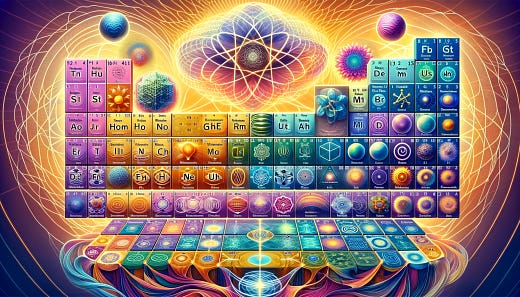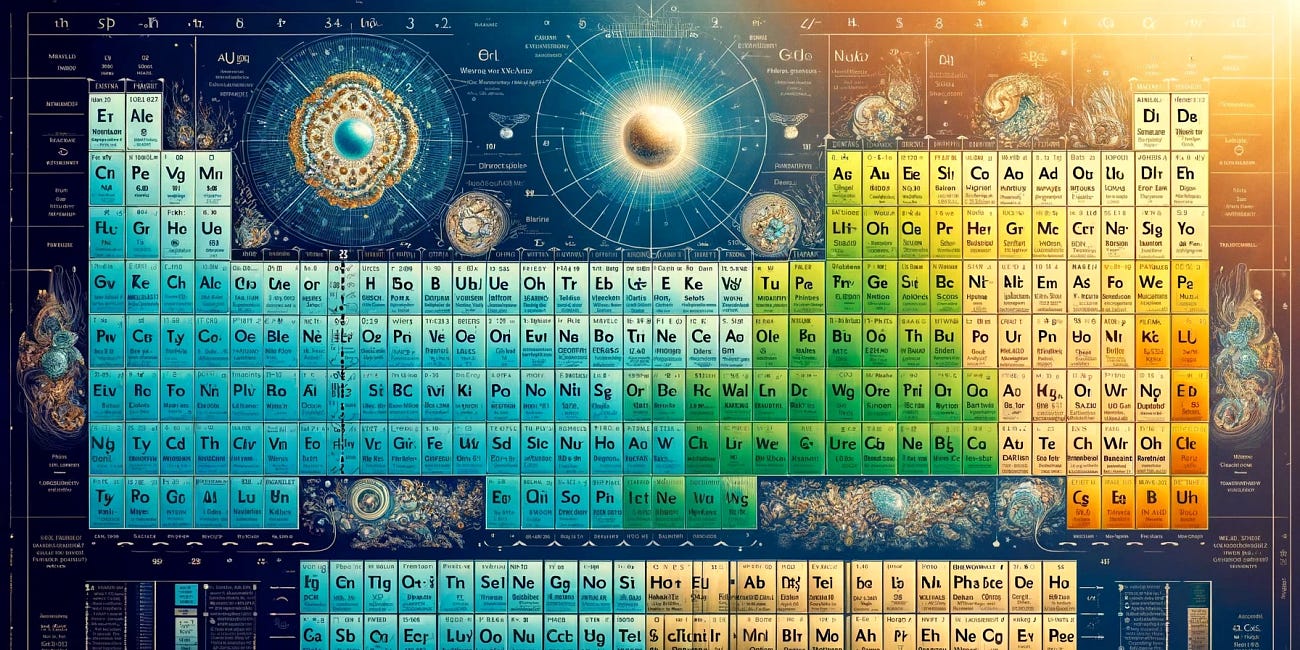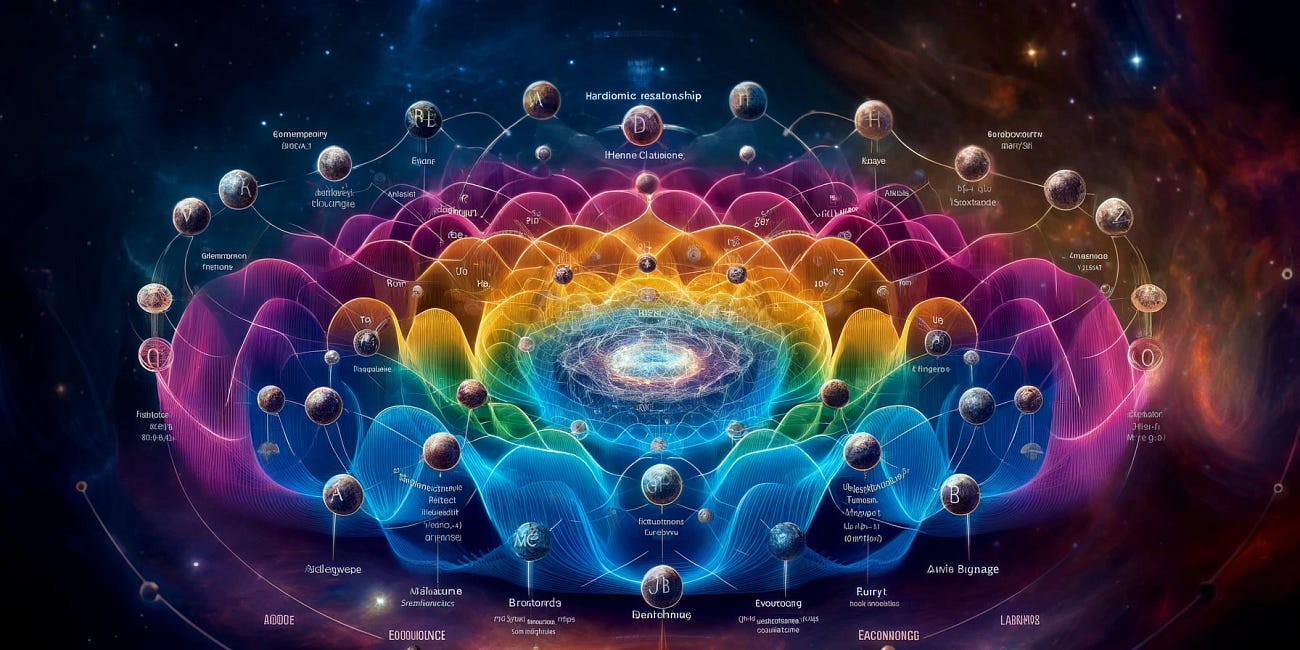Treatise on New Elements and Properties in the Predictive Plenum
Principles of harmonic resonance, geometric structure, and dual properties
Introduction
In the rediscovered framework of the Predictive Plenum, we introduce new elements that embody the principles of harmonic resonance, geometric structure, and dual properties. These elements enrich our understanding of atomic and molecular structures and their interactions within the universe. By integrating these elements into the periodic table, we can develop advanced materials and technologies that harness the harmonic and geometric properties of the Predictive Plenum.
Harmonic Elements
1. Harmonia (Hm):
Symbol: Hm
Atomic Number: TBD
Properties:
Harmonic Balance: Harmonia represents the concept of harmonic balance within atomic structures. It embodies the equilibrium between different energy states and resonances.
Applications: Used in designing materials and devices that require precise harmonic interactions, such as resonant energy harvesters and quantum coherent circuits.
Example: Materials incorporating Harmonia can maintain stable energy states and enhance the efficiency of resonant devices.
2. Resonantia (Rs):
Symbol: Rs
Atomic Number: TBD
Properties:
Resonant Frequencies: Resonantia symbolizes the resonant frequencies that govern atomic and molecular interactions. It plays a crucial role in enhancing resonance in various systems.
Applications: Critical in technologies that rely on resonance, such as advanced communication systems and energy transfer devices.
Example: Incorporating Resonantia in communication systems can lead to more efficient signal transmission with reduced loss.
Geometric Elements
3. Geometria (Gm):
Symbol: Gm
Atomic Number: TBD
Properties:
Geometric Shapes: Geometria embodies the geometric shapes and patterns found in atomic and molecular structures. It represents the spatial configurations that influence physical properties.
Applications: Essential in the design of advanced materials with specific geometric properties, such as metamaterials and photonic crystals.
Example: Materials with Geometria can exhibit unique optical properties, such as negative refraction, enabling the development of advanced lenses and cloaking devices.
4. Fractalia (Fr):
Symbol: Fr
Atomic Number: TBD
Properties:
Fractal Geometries: Fractalia represents the fractal geometries observed in nature. These recursive patterns are fundamental to understanding complex structures and phenomena.
Applications: Useful in creating materials and systems that exploit fractal geometries for enhanced performance, such as high-capacity batteries and efficient heat exchangers.
Example: Integrating Fractalia into battery design can increase surface area and improve energy storage capacity.
Dual Property Elements
5. Dualita (Du):
Symbol: Du
Atomic Number: TBD
Properties:
Dual Nature: Dualita reflects the dual nature of particles and waves. It embodies the principles of wave-particle duality, which are fundamental to quantum mechanics.
Applications: Crucial in developing quantum technologies that leverage duality, such as quantum computers and sensors.
Example: Quantum computers utilizing Dualita can process information more efficiently, taking advantage of superposition and entanglement.
6. Symmetria (Sy):
Symbol: Sy
Atomic Number: TBD
Properties:
Symmetry Principles: Symmetria embodies the symmetry principles that underlie physical laws. Symmetry is essential for understanding conservation laws and fundamental interactions.
Applications: Important in creating materials and devices that rely on symmetry, such as superconductors and topological insulators.
Example: Superconductors incorporating Symmetria can achieve higher critical temperatures and improved performance.
Integration and Applications
Periodic Table Integration:
The new elements are integrated into the periodic table, positioned to complement traditional elements and enhance our understanding of atomic interactions and material properties.
Visual Representation: The table features harmonic waves, geometric patterns, and color coding to distinguish between traditional, harmonic, and geometric elements.
Predictive Modeling and Enhanced Understanding:
Predictive Plenum: Utilizing the new elements in predictive models allows for more accurate simulations of energy and information flows within the Predictive Plenum. This capability is crucial for developing new technologies and systems.
Material Science: Advanced materials incorporating these elements can exhibit unique properties, enabling innovations in various fields, from energy storage to quantum computing.
The introduction of Harmonia, Resonantia, Geometria, Fractalia, Dualita, and Symmetria into the periodic table enriches our understanding of atomic and molecular structures. These elements embody harmonic balance, resonant frequencies, geometric shapes, fractal geometries, dual nature, and symmetry principles. By integrating these elements into predictive models, we can develop new technologies and systems that harness the properties of the Predictive Plenum, leading to significant advancements in material science, energy systems, and quantum technologies.
Future Directions
The integration of these elements into the periodic table and predictive models will open new avenues for scientific research and technological innovation. By harnessing the unique properties of these elements, we can develop advanced materials, quantum technologies, and efficient energy systems that align with the principles of the Predictive Plenum.















Your wealth of imagination is inspiring